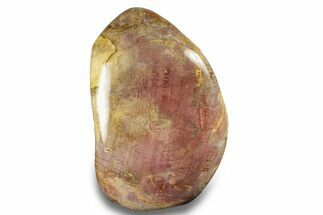This Specimen has been sold.
4.1" Free-Standing, Polished Petrified Wood - Madagascar
This is a 4.1" tall, polished section of colorful petrified wood from Ambilobe, Madagascar. The base of the piece has been cut flat so that it stands up nicely on a hard surface.
This specimen is from the early Triassic period, approximately 220 million years old, close to the time the first dinosaurs appeared on the planet. It is from a genus of conifer called Araucaria: they used to dominate forests during the Jurassic and Cretaceous periods, but now are limited to a handful of species across the southern hemisphere. The most recognized species of Araucaria today are the monkey puzzle, or pewen, trees, native to Chile and Argentina.
This specimen is from the early Triassic period, approximately 220 million years old, close to the time the first dinosaurs appeared on the planet. It is from a genus of conifer called Araucaria: they used to dominate forests during the Jurassic and Cretaceous periods, but now are limited to a handful of species across the southern hemisphere. The most recognized species of Araucaria today are the monkey puzzle, or pewen, trees, native to Chile and Argentina.
About Madagascar Petrified Wood
Madagascar petrified wood comes primarily from extensive Triassic-aged deposits in the Mahajanga Basin of northwestern Madagascar, where ancient conifer forests—often attributed to species related to Araucarioxylon—were buried by volcanic ash and floodplain sediments roughly 225–240 million years ago. Over immense spans of time, silica-rich fluids percolated through these sediments, replacing the cellular structure of the wood with chalcedony, jasper, agate, and quartz while preserving growth rings, bark textures, and even microscopic details. The region’s unique geochemistry—especially its iron, manganese, and occasionally copper content—produces the vivid palette Madagascar petrified wood is famous for, including deep brick reds, golden yellows, smoky blacks, and pastel pinks. Many logs are found fully silicified and naturally fractured into large, rounded segments that local artisans cut into slabs, spheres, eggs, and freeforms. These deposits stretch across arid badlands where erosion steadily exposes new material, making Madagascar one of the world’s premier sources of highly colorful, beautifully patterned fossil wood.
Madagascar petrified wood comes primarily from extensive Triassic-aged deposits in the Mahajanga Basin of northwestern Madagascar, where ancient conifer forests—often attributed to species related to Araucarioxylon—were buried by volcanic ash and floodplain sediments roughly 225–240 million years ago. Over immense spans of time, silica-rich fluids percolated through these sediments, replacing the cellular structure of the wood with chalcedony, jasper, agate, and quartz while preserving growth rings, bark textures, and even microscopic details. The region’s unique geochemistry—especially its iron, manganese, and occasionally copper content—produces the vivid palette Madagascar petrified wood is famous for, including deep brick reds, golden yellows, smoky blacks, and pastel pinks. Many logs are found fully silicified and naturally fractured into large, rounded segments that local artisans cut into slabs, spheres, eggs, and freeforms. These deposits stretch across arid badlands where erosion steadily exposes new material, making Madagascar one of the world’s premier sources of highly colorful, beautifully patterned fossil wood.
SPECIES
Araucaria (Conifer)
LOCATION
Ambilobe, Madagascar
FORMATION
Isalo II Formation
SIZE
4.1 x 3.7 x 2.1"
CATEGORY
SUB CATEGORY
ITEM
#271808
We guarantee the authenticity of all of our specimens.
 Reviews
Reviews











